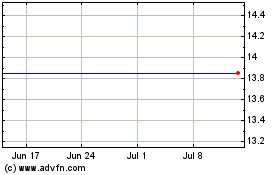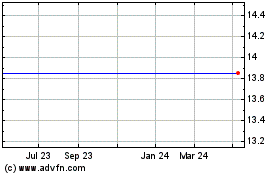Cephalogics Awarded a US Patent for Its High-Density Diffuse Optical Tomography System
January 17 2017 - 9:19AM
Business Wire
The Cephalogics HD-DOT system covered by US Patent
9,498,134 B1 collects data to measure tissue oxygenation in
the brain and produce images of hemoglobin concentrations over
large regions, which provide valuable information about a patient’s
brain perfusion status.
Core applications include ischemic and hemorrhagic stroke with
the intention to identify perfusion deficits and drive patients to
therapeutic interventions more rapidly.
Cephalogics today announced that it was granted US Patent
9,489,134 B1 for its High-Density Diffuse Optical Tomography
(HD-DOT) system, which is designed to deliver real-time
brain-specific measurements and imaging of cerebral perfusion
status in brain-injured patients.
The compact portable design of the system will
enable fast spot check assessments and continuous
monitoring of large cerebrovascular regions to help clinicians
identify perfusion deficits in order to trigger interventions
in patients at risk for ischemia. Currently, less than 10% of
ischemic stroke patients receive efficacious
endovascular treatment. Major reasons for this lack of
treatment are delays in initial diagnosis and delays in transport
to comprehensive stroke centers that are properly equipped to
treat such patients. By enabling faster and earlier identification
of perfusion deficits, Cephalogics aims to reduce these delays and
increase the number of patients eligible for endovascular
treatment.
This patent supports Cephalogics’ efforts to provide clinicians
with a non-invasive method for monitoring the perfusion status of
brain-injured patients and the impact of interventions. Existing
commercial light-based devices currently used for non-invasive
brain monitoring are typically confounded by changes in
extra-cerebral tissue like skin, scalp, skull,
and cerebrospinal fluid surrounding the brain. This limits
their clinical utility. Cephalogics has developed technology
to substantially eliminate the extra-cerebral tissue effects.
In particular, this patent protects novel processing techniques
developed by Cephalogics to improve brain specificity and create
high-quality images of cerebral tissue hemoglobin oxygenation.
“The Cephalogics IP constitutes an important advancement in the
capability to eliminate extra-cerebral effects using a light-based
device, and delivers on the promise to provide reliable,
non-invasive, bedside, brain-specific measurement and imaging,”
said Russ Herrig, Vice President of Engineering at Cephalogics.
The combination of this patented technical innovation with
Cephalogics’ high-density, multi-wavelength, multi-distance near
infrared (NIR) measurements differentiates Cephalogics’ DOT
technology from other commercially available systems. The patent
covers approaches to reduce noise, improving the system’s ability
to measure the brain while conforming to different head geometries.
These innovative approaches produce high-quality imaging while
improving brain specificity of cerebral perfusion measurements.
"This patent further protects our novel technology that will
help clinicians quickly identify cerebral
perfusion deficits and reduce delays to treatment,” said Jeff
Caputo, General Manager of Cephalogics. “Our goal is to partner
with the medical community to help make timely and efficacious
endovascular treatment possible for the hundreds of thousands of
patients who are delayed and unable to receive this treatment
today.”
For more information about Cephalogics,
visit www.cephalogics.com.
About CephalogicsCephalogics is developing a
non-invasive, portable brain perfusion imaging system that is
designed to provide clinicians with critical information for
detecting and treating perfusion deficits and avoiding ischemia in
brain-injured patients. The system is designed to "see” the brain
through hair, skin and skull, mapping oxygen saturation in the
brain and help to facilitate early interventions, improve outcomes
and reduce healthcare costs. Cephalogics' system utilizes Diffuse
Optical Tomography (DOT) to provide bedside imaging of multiple
cerebrovascular regions within a patient's brain. The system's
sensors consist of compact, high-density arrays with numerous near
infrared (NIR) laser light sources and detectors to provide
hundreds of simultaneous spatially resolved measurements per
region. These measurements are processed in real time to produce
regional maps of the oxygen saturation in cerebral tissue. Each
sensor array covers a cerebrovascular area of approximately 40cm2.
Cephalogics is developing and commercializing an imaging system
based on technology invented by Dr. Joseph P. Culver, a Professor
at Washington University and a leading researcher in the field of
Diffuse Optical Tomography. More information about the company can
be found at www.cephalogics.com.
View source
version on businesswire.com: http://www.businesswire.com/news/home/20170117005915/en/
ArcPoint Strategic CommunicationsChristine Dunn, 617-314-6441
x101cdunn@arcpointstrategy.com
Allied Minds (LSE:ALM)
Historical Stock Chart
From Mar 2024 to Apr 2024

Allied Minds (LSE:ALM)
Historical Stock Chart
From Apr 2023 to Apr 2024
